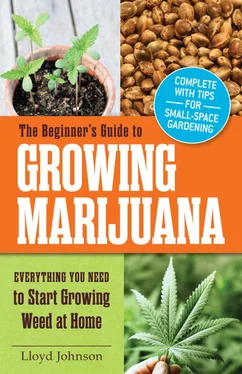Money Smart
Some cost-conscious growers use fans from old computer cabinets, generally available from electronics liquidators very cheaply. Dimmer switches can be used to regulate the speed and noise of the fans. Silicon should be used to secure the fans to PVC pipe run through floor and ceiling holes. Use more silicon to dampen the vibration of the fans, as the walls will resonate to the oscillations.
Odor Control
Cannabis plants emit a strong and distinctive odor during their reproductive phase. This can alert thieves or law enforcement that you are growing cannabis, as eventually this odor is vented to the outside of your house. It can also permeate the inside of a home, again leading casual visitors to either wonder what the smell is or to know what the smell is, which can be worse, depending on their views about cannabis.
Most indoor growers eliminate the odor danger by forcing the grow room air through a carbon filter. Many home cultivators simply attach a large carbon filter to their air extraction system and filter any smell before the air is expelled from the grow room.
Another way of eliminating odor is by installing an ozone generator in the extraction ducting. Air is forced past the ozone generator by the extraction fan, and the air is neutralized as it mixes with the ozone.
If you are going to need any ducting or electrical work done by an outside repairman, plan ahead and get this done first, before your growing area looks like anything but a basement, potential shop, or art room. You do not have to discuss anything with a contractor, but casual conversation about a pottery studio can deflect any speculation you are setting up a cannabis grow.
Room Prep
Once you select the location and have the electrical and exhaust systems figured out, you need to prepare it. First, completely clean the room. Floors need to be thoroughly cleaned, and the walls should also be sprayed with a light bleach solution and wiped down.
Any windows in the grow area must be covered completely and checked from outside at night for light loss. Unless they are made of concrete, the floors should be covered in plastic to prevent water damage. You will be gardening in this room, and water spills can happen. Whether the floor is yours or your landlord’s, you do not want to create a mold-inducing environment from wet wood or soaked tile grout.
Paint the walls flat white, choosing paint with high titanium dioxide content to maximize reflectivity. Some indoor growers cover the walls of their grow room with some type of reflective material. The most common is 6 mil (150 µm) PVC plastic sheeting that is white on the room side and black to the wall. The white side reflects light, and the black side reduces mold growth. Other common coverings are Mylar sheeting and Astro-Foil, both of which reflect heat. There is also the option of Foylon, a foil-laminated, reinforced fabric that some growers use successfully. Some indoor growers have also experimented with using tin foil to intensify light. This is not advised, as the foil can actually focus light into hot beams and burn holes through the plants’ leaves.
A broad, well-secured shelf above the main grow area can be used to root cuttings and germinate seedlings. The area will stay very warm, eliminating the need for a germination warming pad. If you are only using one grow room, hang a lightproof curtain to separate the shelf from the main area when the lights are on flowering cycle settings.
Lights
Lumen is a measurement of light output. It refers to the amount of light emitted by one candle that falls on one square foot of surface located at a distance of one foot from the candle. Traditionally, lumens have been the benchmark of a lamp’s ability to grow plants, meaning the brighter the lamp, the better the plant performs. However, studies have shown that using a broader color spectrum lamp causes much better plant growth than a lamp with high-lumen output.
High-intensity discharge (HID) is a special type of lighting that is intensely bright. An HID lighting system consists of a ballast, reflector, socket, and lamp (light bulb). The ballast acts like the engine, converting and driving energy to illuminate the lamp. HID lighting options for plant growth are typically metal halide (MH) or high-pressure sodium (HPS) systems.
Metal halide lamps provide more of the blue/green spectrum, which is ideal for plants that are in a vegetative stage. MH lamps provide a more natural appearance in color and are typically for plants that have no natural light available. Cannabis can do very well grown full cycle under MH, but get daylight halide for best results.
HPS lamps provide more yellow/orange/red spectrum, which is perfect for plants that are actively flowering. Ideally, you would use MH to grow your indoor plants and HPS to flower them, but either choice is quite suitable for the entire cycle.
Money Smart
An easy way to figure out your projected power bill for grow room lights is to multiply the grow room’s total bulb wattage times the number of hours of operation and divide by 1,000. This figure is the number of kilowatt-hours of electricity used. (Example: a 400-watt lamp running for 18 hours will use 7.2 kilowatt-hours.) Check your power bill for the cost of each kilowatt-hour. Then multiply the number of kilowatt-hours used by the cost of a kilowatt-hour to figure the cost to run your light for that many hours.
Traditionally, fluorescent lighting was used for seedlings, cuttings, and plants with low light-level requirements, and HID was used for established plants and plants with higher light-level requirements. Advances in fluorescent lighting technology have provided more options for indoor growers. T5 fluorescent lighting is the latest in plant-growth lighting. T5’s high light output combined with low heat and energy consumption makes it another light source choice for the indoor cannabis grower.
Your budget will decide how complex your initial lighting and ventilation setups can be. If you are growing medically, many compassion centers have used lighting setups available for reasonable prices. Always do your research, and visit indoor agricultural stores and ask questions. Indoor growing technology is changing radically and rapidly.
Containers
Most indoor cannabis growers use containers that hold between two and five gallons of soil—a good compromise in terms of weight, space, and cost. They can be moved easily and hold an adequate reservoir of water and nutrients to support a large indoor plant.
You can calculate the right size containers to use by the amount of light per square foot. For a moderate light, or 15 to 25 watts per square foot, you should use a minimum of one-gallon containers, but preferably three-gallon containers. For plants receiving more light, or over 25 watts per square foot, use at least three-gallon containers, but preferably eight-gallon containers. The containers must have several holes in the bottom to assure drainage. Growers typically use black plastic nursery pots, but you can use flowerpots, plastic buckets, small trash cans, or plastic grow bags.
In its natural state outdoors, cannabis can grow an extensive root system, especially in dry areas where the main taproot can grow more than six feet deep in its search for water. Cannabis also has a fibrous network of fine, lateral roots that branch off the main taproot. In moister environments with nutrient-rich soil, the lateral roots are able to supply water and nutritive needs, and the taproot can remain small; cannabis will adjust to the indoor grow’s space limitations as long as you feed and water properly.
Читать дальше












